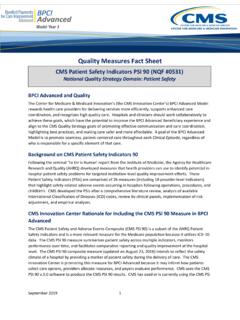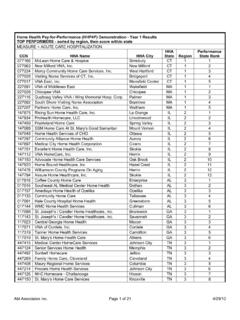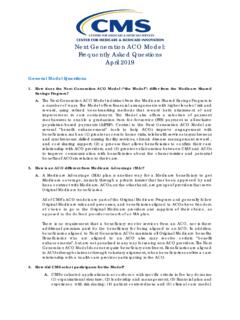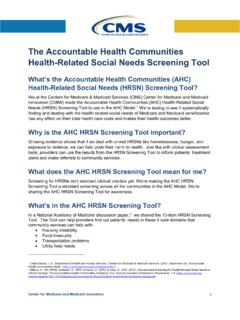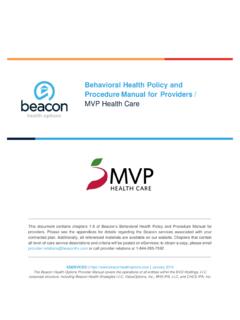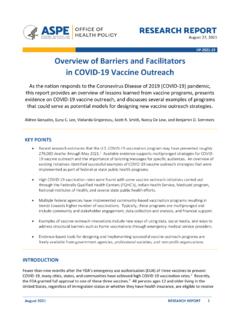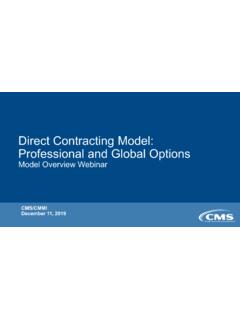Transcription of Direct Contracting (Professional and Global) Frequently ...
1 Direct Contracting (Professional and Global) Frequently Asked Questions Version 3 Date: October 2020 Contents General Questions .. 2 Application 6 9 Beneficiary Benefit Enhancements and Beneficiary Engagement Incentives ..17 Financial Quality and Appendix ..23 General Questions 1. Q: What is the Direct Contracting Model? The Direct Contracting Model creates a new opportunity for the Centers for Medicare & medicaid Services (CMS) Center for Medicare and medicaid Innovation (Innovation Center) to test an array of financial risk-sharing arrangements expected to reduce Medicare expenditures while preserving or enhancing the quality of care furnished to beneficiaries.
2 The Direct Contracting Model leverages lessons learned from other Medicare Accountable Care Organization (ACO) initiatives, such as the Medicare Shared Savings Program and the Next Generation ACO (NGACO) Model, as well as innovative approaches from Medicare Advantage (MA) and private sector risk-sharing arrangements. This model is part of a strategy by the CMS Innovation Center to use the redesign of primary care as a platform to drive broader health care delivery system reform. The model creates a variety of pathways for participants to take on financial risk supported by enhanced flexibilities. Because the model reduces burden, supports a focus on complex, chronically and seriously ill patients, and aims to encourage organizations to participate that have not typically participated in Medicare fee-for-service (FFS) Innovation Center models, we anticipate that this model will appeal to a broad range of physician organizations and other types of health organizations.
3 2. Q: What are the model options under Direct Contracting ? The CMS Innovation Center will test up to three voluntary risk-sharing options: 1) Professional, a lower-risk option (50 percent Shared Savings/Shared Losses) and Primary Care Capitation (PCC) equal to seven percent of the total cost of care benchmark for enhanced primary care services; and 2) Global, a full risk option (100 percent Shared Savings/Shared Losses) and either PCC or Total Care Capitation (TCC). CMS has also sought comment on a potential third option, the Geographic Option, which is another full risk option (100 percent Shared Savings/Shared Losses) that will offer an opportunity for participants to assume total cost of care risk for Medicare Parts A and B services for Medicare FFS beneficiaries in a defined target region. Please note that the current Request for Applications (RFA) is for the Professional and Global Options of Direct Contracting only. CMS anticipates issuing an RFA for the Geographic Option at a later date.
4 3. Q: What are the benefits of participating in Direct Contracting ? Direct Contracting is intended to test whether the risk-based payment strategies available under the model align financial incentives and offer model participants ( Direct Contracting Entities or DCEs) flexibility in engaging health care providers and patients in care delivery that results in preserving or enhancing quality of care while at the same time reducing the total cost of care. Specifically, Direct Contracting offers: Multiple risk-sharing arrangements, Flexible beneficiary alignment options, including enhancements to voluntary alignment relative to existing Medicare initiatives, Capitation payment options that vary by risk-sharing arrangement, Benefit enhancements and payment rule waivers to improve care coordination and service delivery, A focus on complex chronic and seriously ill beneficiaries, and Options for organizations that have not participated in Medicare FFS previously 2 4.
5 Q: How many years is Direct Contracting ? (Updated, October 2020) The model will be implemented over six performance years (PY1-6), with an optional initial Implementation Period (IP). The IP will occur from October 2020 through March 2021, PY1 will occur from April 2021 through December 2021, and PY2, PY3, PY4, PY5 and PY6 will occur in calendar years 2022, 2023, 2024, 2025, and 2026 respectively. Note that the addition of PY6 is a policy change from the RFA due to the challenges posed by coronavirus disease 2019. Since a number of model design features vary by year, we have summarized the changes here along with the original policy from the RFA for reference (note that the parameters listed in the table below apply both to DCEs that start in PY1/2021 and PY2/2022): Revised model timeline and time-dependent model parameters : Calendar year / PY Benchmark discount for Global DCEs New Entrant / High Needs DCEs beneficiary minimum New Entrant & High Needs DCEs Benchmarking Earn back for 5% quality withhold 2021*/PY1 2% 1,000 / 250 Rate book-driven 1% performance, 4% reporting 2022/PY2 2% 1,000 / 250 Rate book-driven 1% performance, 4% reporting 2023/PY3 3% 2,000 / 500 Rate book-driven 5% performance 2024/PY4 4% 3,000 / 750 Rate book-driven 5% performance 2025/PY5 5% 5,000 / 1,200 Baseline-driven 5% performance 2026/PY6 5% 5,000 / 1,400 Baseline-driven 5% performance * April 1 December 31, 2021 Original model timeline and time-dependent model parameters from the RFA.
6 Calendar year / PY Benchmark discount for Global DCEs New Entrant / High Needs DCEs beneficiary minimum New Entrant & High Needs DCEs Benchmarking Earnback for 5% quality withhold 2021/PY1 2% 1,000 / 250 Rate book-driven 5% reporting 2022/PY2 2% 2,000 / 500 Rate book-driven 5% performance 2023/PY3 3% 3,000 / 750 Rate book-driven 5% performance 2024/PY4 4% 5,000 / 1,200 Baseline-driven 5% performance 2025/PY5 5% 5,000 / 1,400 Baseline-driven 5% performance 5. Q: What is the purpose of the Implementation Period (IP) and when will it begin? To help organizations new to Medicare FFS and/or Innovation Center models build an aligned Medicare FFS population, Direct Contracting provides enhanced opportunities for voluntary alignment relative to existing Medicare initiatives. The optional IP provides DCEs with additional time to engage in beneficiary alignment activities and plan their care coordination and management strategies prior to the first performance year (PY2021), which begins April 1, 2021.
7 The optional IP will begin in October 2020. 3 6. Q: What is a DCE? A DCE is a legal entity which participates in Direct Contracting pursuant to a Participation Agreement with CMS. Various types of organizations may apply to become a DCE including Accountable Care Organizations (ACOs). Under Direct Contracting , there will be three types of DCEs with different characteristics and operational parameters. These three types of DCEs are: 1. Standard DCEs DCEs comprised of organizations that generally have experience serving Medicare FFS beneficiaries, including Medicare-only and dually eligible beneficiaries, who are aligned to a DCE through voluntary alignment or claims-based alignment. These organizations may have previously participated in section 1115A models involving shared savings models ( , Next Generation ACO Model and Pioneer ACO Model) and/or the Shared Savings Program.
8 Alternatively, new organizations, composed of existing Medicare FFS providers and suppliers, may be created in order to apply to participate as this DCE type. In either case, CMS expects that providers and suppliers participating within these organizations would have substantial experience serving Medicare FFS beneficiaries. 2. New Entrant DCEs DCEs comprised of organizations that have not traditionally provided services to a Medicare FFS population and that will primarily rely on voluntary alignment, at least in the first few performance years of the model, to attain the minimum number of aligned beneficiaries. Claims-based alignment will also be utilized. 3. High Needs Population DCEs DCEs that serve FFS Medicare beneficiaries with complex needs, including dually eligible beneficiaries, who are aligned to the DCE through voluntary alignment or claims-based alignment. These DCEs are expected to use a model of care designed to serve individuals with complex needs, like the one employed by the Programs of All-Inclusive Care for the Elderly (PACE), to coordinate care for their aligned beneficiaries.
9 7. Q: How can a DCE assess if they meet the requirements to be a Standard DCE, New Entrant DCE or High Needs Population DCE, for example, if they have sufficient level of experience with Medicare FFS to be a Standard DCE? (Updated, October 2020) Key criteria are outlined below. Complete details of each of the three DCE types are available in the RFA. Standard DCEs Organizations with substantial experience serving Medicare FFS beneficiaries. These may be organizations that previously participated in section 1115A shared savings models ( , Next Generation ACO Model and Pioneer ACO Model) and/or the Shared Savings Program, or new organizations, composed of existing Medicare FFS providers and suppliers created in order to participate in Direct Contracting . Required to have a minimum of 5,000 aligned beneficiaries prior to the start of each Performance Year from PY1 through PY6. New Entrant DCEs Organizations with less experience serving a Medicare FFS population and / or taking risk for FFS Medicare beneficiaries.
10 May not have more than 50% of DC Participant Providers with prior experience in the Shared Savings Program, the Next Generation ACO Model, the Comprehensive ESRD Care Model, the Pioneer ACO Model or CPC+ Model* 4 Must meet an increasing minimum number of aligned beneficiaries, with a minimum of at least 1,000 beneficiaries prior to the start of PY1 and PY2, 2,000 prior to the start of PY3, 3,000 prior to the start of PY4, and 5,000 prior to the start of PY5 and PY6. May not have more than 3,000 beneficiaries that are alignable through claims-based alignment in any base year (2017, 2018 and 2019) or in Performance Years 1-4. CMS will evaluate this by assessing the volume of services provided by the applicant s proposed DC Participant Providers to Medicare FFS beneficiaries. Any FFS beneficiaries with a plurality of Primary Care Qualified Evaluation & Management (PQEM) claims billed by a DCE s proposed DC Participant Providers in a given year will be considered alignable in that year*.



